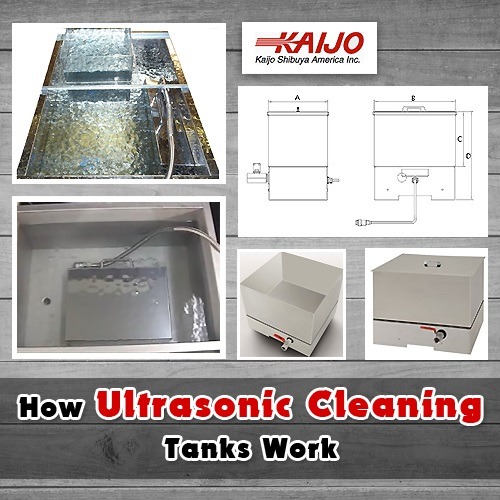How Ultrasonic Cleaning Tanks Work
July 19, 2017
 Ultrasonic cleaning tanks hold the solution that cleans parts and components through the action of cavitation bubbles generated by the ultrasonic sound waves. An ultrasonic generator produces the electric signal and transducers mounted on the tanks convert the signal into waves in the cleaning liquid. The cavitation bubbles deliver a strong scrubbing action throughout the liquid and can clean fully in hard-to-reach places.
Ultrasonic cleaning tanks hold the solution that cleans parts and components through the action of cavitation bubbles generated by the ultrasonic sound waves. An ultrasonic generator produces the electric signal and transducers mounted on the tanks convert the signal into waves in the cleaning liquid. The cavitation bubbles deliver a strong scrubbing action throughout the liquid and can clean fully in hard-to-reach places.
Ultrasonic cleaning tanks have to withstand the cleaning action and vibrations created by the transducers and they have to be constructed to satisfy many different cleaning requirements. Kaijo ultrasonic cleaning tanks feature high-quality construction and provide reliable cleaning performance. The tanks are designed for use in industrial cleaning applications and clean parts and components quickly and completely. A wide range of sizes designed for use at 600 W or 1200 W cleaning power is available.
Tank Construction
Kaijo’s ultrasonic cleaning tanks are made of thick gloss polished stainless steel to provide a stable structure for the mounted transducers and as an inert container for the cleaning liquid. Kaijo can supply specific tanks designed to work with Kaijo ultrasonic generators and custom-designed tanks are also available.
Ultrasonic cleaning tanks have to be sized to hold the parts to be cleaned. Parts are usually suspended in a basket to avoid contact with the sides or bottom of the tank where they could suffer damage due to vibrations. The basket has to be large enough to hold the parts to be cleaned and has to fit inside the tank
Kaijo has an extensive range of standard tank sizes and can supply custom tanks sized to customer applications. The tank length determines the size of the largest piece a tank can hold and standard tanks are available in lengths from 370 mm (14.6 in.) to 550 mm (21.7 in.) while custom tanks can be larger if required.
Ultrasonic Cleaning Tank Operation
Kaijo tanks are available with mounted transducers and generators operating at 26 kHz, 38 kHz or 78kHz. These ultrasonic cleaning tanks are complete systems that deliver robust cleaning action, typically cleaning most parts in about 10 minutes.
For example, the highly reliable Phenix III generator can be combined with Kaijo’s ultrasonic cleaning tanks and mounted transducers to form a cost-effective turnkey system. Such a combination can clean glass, ceramics, machined parts and food as well as jewelry, cosmetics, and medical devices. The transducers are heat resistant up to 100 degrees Centigrade and Kaijo’s Water Resonance System is available to substantially increase cleaning effectiveness.
The tanks can operate with a water bath but adding a mild detergent and heating the cleaning solution can speed up cleaning performance for some contaminants. This is especially true of greasy or waxy dirt that softens at higher temperatures and is dissolved by detergents. The ultrasonic system can clean complicated shapes and crevices as well as dead-end holes and areas inaccessible for mechanical cleaning methods.
Kaijo Can Help
Kaijo has over 60 years of experience in ultrasonic cleaning technology and can help customers select the best system and configuration for their cleaning application. Selecting the appropriate tank, frequency, power and system features ensures that the ultrasonic cleaning system performs up to its capability. When the selected system can either carry out a single cleaning task effectively or has the flexibility to clean multiple different parts well, it maximizes the return on investment and improves production line efficiency.
Kaijo’s specialists can help analyze a customer’s cleaning requirements and propose effective ultrasonic cleaning solutions. Consultations with ultrasonic cleaning experts are free and Kaijo’s team can recommend specific ultrasonic cleaning tanks and systems that match a customer’s needs. A well-designed and properly configured ultrasonic system can reduce costs, improve output quality and increase productivity.





